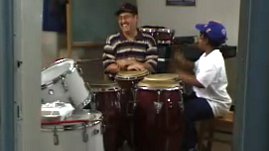Teachers' Domain - Digital Media for the Classroom and Professional Development
User: Preview

Source: EGG: the arts show: "Off the Charts"


Funding for the VITAL/Ready to Teach collection was secured through the United States Department of Education under the Ready to Teach Program.
This video segment from EGG:the arts show documents Camilo Molina Gaetan, a fourth grader from Spanish Harlem, as he works to become a master drummer. He is learning to play many styles of Afro-Caribbean music like the Rumba from Cuba and the Bomba from Puerto Rico. He has been playing drums since he was four years old. Camilo wants to play all kinds of drums. His teacher enjoys teaching Camilo because he says it is important to pass the tradition down to the next generation.
Culture, ethnicity, social perspective, history, perspectives
The following Frame, Focus and Follow-up suggestions are best suited for middle school students using this video in an English language arts or social studies lesson. Be sure to modify the questions to meet your students' instructional needs.
What is Frame, Focus and Follow-up?
Frame (ELA) A story can be told from many different perspectives: a social perspective, a cultural perspective, a historic perspective, or an ethnic perspective. How do these perspectives differ from each other?
Focus (ELA) As you watch the segment, determine from which perspectives Camilo and his teacher are speaking.
Follow Up (ELA) Discuss the many perspectives represented in the videos. Explain why it is important for readers and viewers to be able to distinguish among various perspectives in texts. How does it help you understand the text fully?
Frame (SS) Camilo Molina Gaetan lives in Spanish Harlem in New York City. What do you know about Latino history and culture in New York City? When did some of the first immigrants arrive from the Caribbean? Is there a way to define the terms "Latino" or " Latina"?
Focus (SS) Camilo says the drums were used to communicate. What does he mean by that? Why were the drums used in this way?
Follow Up (SS) What are some of the instruments, musical forms and dance styles associated with Latino culture? For example, what is salsa and rhumba? Do they come from the same place? Map various Latino musical styles, dances and instruments to the islands from where they came. Can they be linked to other places like Africa and Europe?
MAN: I think my ancestors talk to me through the drums. They tell me to keep the faith. They teach me to believe.
BOY: When I was little, it just came to me, I want to play drums. I want to play conga, I want to play bongo, I want to play timbales.
MAN: This boy wants to play drums.
MAN: It’s important to me to pass the tradition down to the next generation.
MAN: I remember as a child, we learned the music on the streets. There was a lot of jam sessions around, in the barrio right here, and all the neighborhoods. Because in those days when we came up, there was no schools. There was Joe the barber or Pete the taxi cab driver that were musicians at night. Rhythms carry a lot of power. They are very hypnotic. They carry a lot of wisdom in them and they’ve survived hundreds of years.
BOY: Slave owners never let them talk to each other, so, by playing, they would talk to each other.
CAMILO: One bro would play... [ slapping knees ] and the other one would play, you know... They would be talking, an answer and response. That covers both claves. Ah, ah, ah, ah, ah. When you do that, you have both claves.
ALMENDRA: It’s very rare that we get a kid like Camilo, who wants to do it, has the drive to do it. I’ve always got every beat from Johnny like this, like in a snap. Bomba.
ALMENDRA: He’s learning a lot of different styles of music. Rumba from Cuba. I teach him Bomba from Puerto Rico, Plena. I mean, you name it, he’s doing it. That was a good class. It’s always good to have something to drink after...
GAET•N: Johnny is the best teacher. Before he played with Timbolia, he played with Jovani Dalgo.
GAET•N : Mostly he talks about music. Sometimes he tells me about when he was young. I played with him as well.
ALMENDRA: camilo started with me when he was 4 years old. He’s really talented. We play a lot of music together. He’s played in my band. He’s becoming a really great soloist.
GAET•N: When I’m drumming, my mind just goes blank. It’s fun.
ALMENDRA: What we worked on, he’s using and doing it on stage. And sometime he will have the opportunity to share, to pass on whatever he’s learned. Because that’s the only way that we will have this music survive.
WOMAN: Camilo Gaetan!
 Loading Standards
Loading Standards